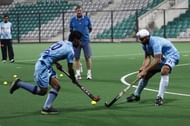Here, Baljit Singh Saini will have to use all the powers at his disposal to keep his midfield in line. He will have to handle the Olympians in the mix very well to make sure they are “grounded” and play like ordinary teammates. It is going to be a challenge to omit some attack minded midfield players for defensive ones. Playing some fast defenders as midfielders could also be a trial option. Here too, Kothajit Singh could be a revelation, with his silky smooth moves, his tackling prowess, and the speed with the ball on his stick. Serious consideration should be given to him to be involved in the defensive scheme of things.
Kayla Sharland from New Zealand, who is a very good midfielder, comes to mind because of her excellent work in defense whenever she’s called on to help out. Kothajit’s communication with his teammates, unfortunately, will need a lot of work. But his tackling skills are good, which should make transitioning to defensive midfield relatively easy.
Manpreet Singh is too attack-minded to be saddled with defensive responsibilities. Although, with his old Ranchi Rhinos coach having a good rapport with him, a reminder of the much-needed defensive responsibility should be possible.
Here, it must be mentioned that coach Gregg Clark has a lot riding on his shoulders, since he would be mentoring these youngsters, giving them a unique style, and would shape their philosophy for the future. We trust that he would bring the European style of play to his midfield. His task may be helped by the traditional midfield strength and toughness that most teams from Punjab bring with them. But he has to sincerely curb their tendency to be rough and to mouth off.
Also, he will have to do something about their “jittery stomachs on big occasions” tendencies. It seems that the current lot of favoured midfielders, minus Devendra Walmiki, seem to be coming from that area. Walmiki, with his German experience and exposure, should bring a sense of calmness to the midfield. His stint with the Mumbai team in the WSH, where he contributed well to the team in a defensive midfield role, should stand him and his coach in good stead. A similar role from his compatriots playing alongside him should also benefit the midfield and help coach Clark.
What was began in the Brasa era –“wingback play”, should be developed by India since they have the speed and the dribbling skills to initiate an attack from deep down in their defensive zone. Maybe a Spain type of defensive philosophy of having all 11 players behind the ball could be experimented with.
Since an all-out attacking midfield is what is traditional, a mobile defensive structure in those situations is going to be critical. Most European teams, after scouting the Indian attacking prowess, will strategise towards counterattack, winning PCs and effectively, and with the resultant goals, put further pressure on the Indian midfield to attack even more.
A mantra of limiting the PCs conceded and reducing the number of circle penetrations should be paramount in the minds of our midfielders, even if it is to the detriment of their natural attacking tendency.
Development of inter-midfield buildup play should be encouraged.
Again, this goes against the grain of Indian hockey culture. Lots of practice and effort on the training ground would have to be expended on this aspect. Passing with accuracy and minimizing missed passes would have to be worked on.
For Indians, soccer-style interchanging roles of midfielders and forwards, depending on ball movement and the ball carrier, is new; that is why, these concepts would have to be introduced and perfected. This would add tremendous potency to the attack side of things. Also, in the defensive scheme of things, this would be extremely useful.
All-rounders’ ability to play multiple positions.
This is the need of the hour and should not be difficult to achieve. The only stumbling block is the selection process, which is weighted towards the selectors and not as much towards the coach. The likelihood of the coach’s opinion being vetoed is strong. Finally, a true selection needs to done without regional bias or “favourites” and there should be no hesitation in sitting down established stars for non-performance.
Back 4 – traditional weakness and its correction.
With a solid goalkeeper behind them, mentally the defenders in front should be more relaxed. Serious consideration could be given to playing a 3 defender-cum-sweeper system. But again, the key would be the understanding and intelligence of the players to play in a new system.
This would be the most difficult task for coach Gregg Clark. Multiple coaches before him have not been able to solve this puzzle. Here, the experience and stint of director Oltmans with Pakistan should help bring about ideas to go about and achieve this. It must be said that the Pakistanis have improved tremendously in this aspect.
Finally, as was evident during the time of coach Brasa, a premium on passing did give that Indian team a sense of modernity. Even if this aspect is taken up on a war footing by this group of talented youngsters, their battle will be half done. We can only hope for the future.
The current young Indian team line up has all the traditional faults of Indian teams before them. The only positive thing about this team are the coaches. There is still a lot of work that needs to be done on the defensive end of the field.

